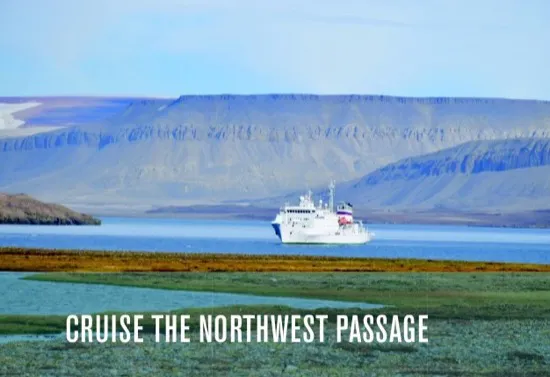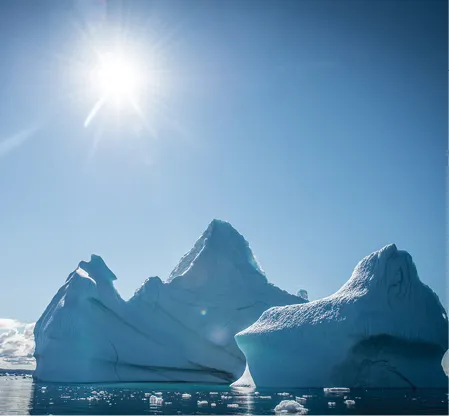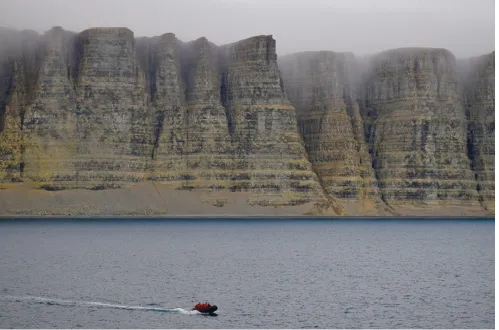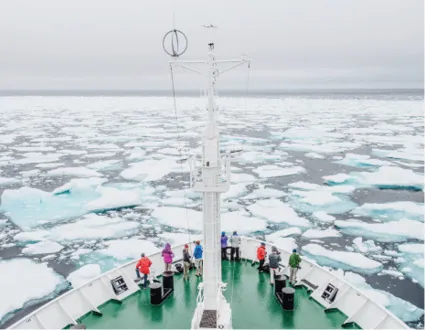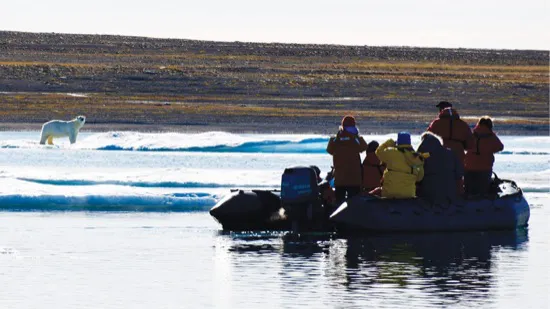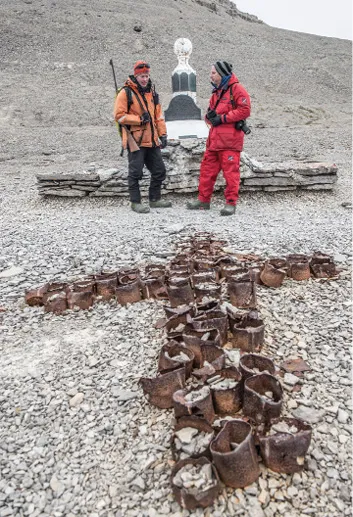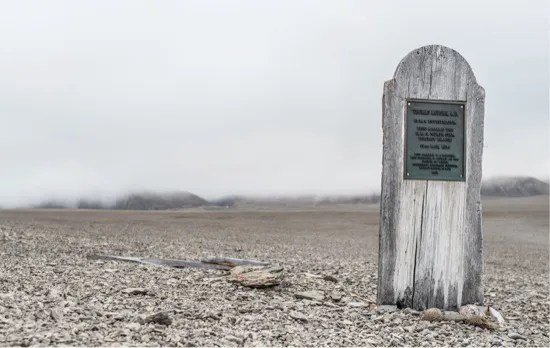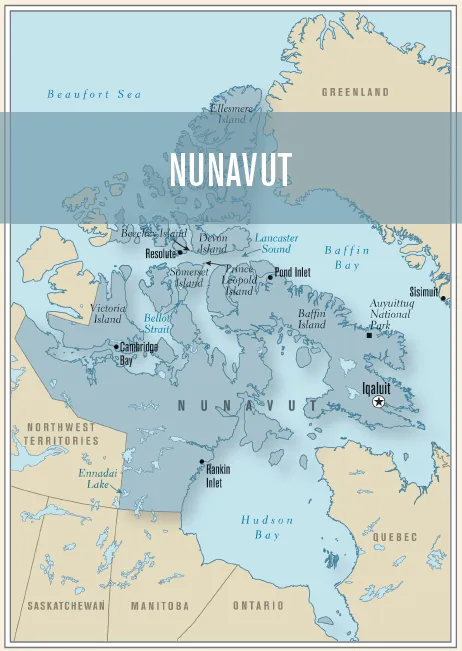![]()
NUNAVUT
![]()
In those Northwest Voyages
Where navigation must be executed
In exquisite sort.
— John Davis, 1594
It suspends from the roof of the world, an intricate chandelier of a frozen archipelago, illuminating the wind-burned faces of those in search of adventure. A desolate landscape of ice and rock that, nevertheless, promises wealth and glory, and, like any light burning too bright, doom for those that don’t pay heed. The Northwest Passage connects Europe and Asia across the Arctic. A safe, reliable passage could double the speed and halve the cost of traditional shipping routes. Explorers of legend first sailed in search of its discovery as early as the sixteenth century, finding themselves in a forbidding and unpredictable polar wasteland, home to strange creatures, curious natives, desolate storms, and labyrinthine icy passages trapping boats like bugs in a spider’s web. It didn’t stop them coming, sea dog captains whose names we still recall hundreds of years later. Frobisher Bay, Davis Strait, McClintock Channel, Baffin Island, Fort Ross — legends of Arctic exploration, and yet the most famous of all has no great islands or bays named after him. Sir John Franklin even casts a shadow over the first man who successfully found his way through, the Norwegian Roald Amundsen. The fate of Franklin’s Expedition (see page 89) remains a mystery, the scarred and scattered bones found on several islands suggesting foul depths of human misery. Today, from the comfort of an ice-strengthened expedition ship, we can follow Franklin’s footsteps, at least to the point where they fade away.
“From Vancouver, turn right, turn right, turn right, turn right, turn right.”
— Executive Director of the Vancouver Maritime Museum and skipper of the St. Roche II, Ken Burton explains the directions for his successful twenty-four-thousand-nautical-mile, 169-day circumnavigation of North America, breaking several records in the process.
Anyone can attempt the Northwest Passage now in a manner of comfort early explorers could never have imagined. Attracting passengers from around the world, some of us are here for the history, others for the landscape and wildlife. All are aware that we are embarking on a true northern adventure into an astonishing part of the world that very few people will ever see. Bundle up, bucket listers. Bring your cameras, your books, and your appetite for curiosity. The charter flight from Ottawa to Kangerlussuaq, Greenland, is taxiing down the runway. Awaiting us is One Ocean Expedition’s 117-metre-long, eighteen-metre-wide Akademik Sergey Vavilov. Awaiting us is a once-in-a-lifetime Arctic adventure.
Eighty-four passengers, sixty-six crew, ten Zodiacs, and almost two thousand nautical miles to sail in twelve days if we hope to return home via a charter flight from Cambridge Bay to Edmonton. We begin in Greenland, the world’s biggest island and the least densely populated country in the world, because Franklin’s final voyage passed through here, too, filling up on supplies and sending five unfit (but ultimately lucky) men home before the ships crossed Baffin Bay and promptly vanished. A thick ice-sheet blankets most of Greenland, with a small, primarily Inuit population clinging to the narrow shorelines. There is not a tree to be found anywhere, but farther up the coast, in the town of Sisimiut, it is anything but drab. Houses are painted bright colours, modern supermarkets sell fresh produce, and locals are stylishly Scandinavian, as befits a nation still officially governed by Denmark.
Life in Greenland is distinctly different from life in the Canadian Arctic, even though culturally the Inuit communities are similar. As we wander the town, finding healthy Icelandic horses grazing in a field of Arctic poppies and dozens of boisterous barking huskies, the passengers sniff each other out. There is a large group from the Vancouver Aquarium, media from New York and Germany, a museum director who happens to have been the last Canadian to circumnavigate North America, scientists, artists, photographers, writers, families, couples, and, of course, travellers, like yourself.
More than just a cruise ship, the Vavilov will conduct important Arctic research, transform into a floating museum, host presentations and exhibits that include original maps from the 1850s and relics from the recently discovered Erebus (see page 90). We are, after all, on the same vessel that was instrumental in the discovery of Franklin’s flagship in September 2014. While One Ocean staff is comprised of cheery North Americans, the ship’s working crew is Russian, our rooms basic yet comfortable. Meals are outstanding; a Scotch bar is well-stocked, fine wine will flow. There’s a Finnish sauna and a hot tub on the upper deck. But if you’re thinking a glitzy floating hotel can take on the Northwest Passage, think again. Due to heavy sea ice and prowling icebergs, there’s no guarantee that even our expedition ship will make it. This is a journey of discovery on the icy fringes of adventure tourism. When the highlights include grave markers of dead sailors on one of the bleakest islands you can imagine, nobody is here for the tan and Jimmy Buffett’s “Margaritaville.”
Crossing the Davis Strait north toward Baffin Island brings monstrous ten-thousand- year-old icebergs, lurking for unsuspecting boat hulls and maritime disasters. We take the Zodiacs into a jigsaw puzzle of glacial ice and cruise about this frozen sculpture garden, admiring the formations and alien-blue colours, the seabirds standing guard atop each berg like sentinels. Icebergs in the shape of sea dragons and ducks, archways, mushrooms, flowerpots, plateaus, wedges, and a five-storey crown for Poseidon’s head. So many shapes, and this just the tip of a proverbial metaphor!
From the ship’s bridge, a quiet, serious place that is nonetheless open to passengers, I watch the Vavilov cautiously push aside growlers and dense, heart-of-glacier black ice. This is an ice-strengthened vessel, not an icebreaker. Fortunately, a high-pressure zone has calmed the seas for our two-day ocean crossing. Fascinating presentations about Franklin, marine biology, life in the Arctic and beyond keep us busy. When a polar bear is spotted on some sea ice many miles from shore, I understand why Ursus maritimus is classified as a marine mammal.
Beyond the staggering views and intriguing history, any Northwest Passage crossing is a journey of people — the passengers who share meals and excursions and late nights at the bar, the people of the Arctic we encounter in remote northern towns like Pond Inlet. Residents here demonstrate their sport, throat singing, dancing, and drumming at the Cultural Centre. I ask one of them what she thinks about us tourists arriving en masse.
“It’s a little like a human zoo,” she tells me. “We get to see people from all over the world.”
“Wait a second,” I ask. “You mean, we are the ones in the cage?”
“Of course!” She laughs. The Inuit sense of humour is legendary.
Harsh realities are never too far away in the Arctic. We discover during our brief visit that a local family have been seriously injured in a tent fire. Without a resident doctor in Pond Inlet, our ship doctor, Thandi Wilkinson, rushes to help. She spends the next twelve hours frantically trying to save lives, making national news in the process, and receiving a formal letter of gratitude from the Nunavut government. Guests are more than willing to halt our itinerary and put the lives of strangers first. One Ocean’s polar commitment to leave only footprints transcends environmental responsibility. It extends to Arctic communities, too.
Later, a shore excursion at Dundas Harbour on Devon Island shows us just how far those communities stretch into the past. Hiking along the coastline, we encounter the remains of an RCMP camp from the 1920s, sunken stones from five-hundred-year-old Thule settlements, and evidence of the Dorsets, who colonized the central and eastern Arctic two millenniums ago. Highlighter-orange lichen, lime-green mosses, and yellow poppies thrive in the sunshine. Light this far north has a rejuvenating quality, as if Mother Nature has just learned Photoshop. Some life, yes, but death is never far behind. The landscape becomes a rocky desert, leading up to the almost century-old graves of two RCMP offers, overlooking a barren bay. As we sail farther into Lancaster Sound, the surrounding islands exude an alien starkness. No wonder NASA tested its Mars Rover on Devon Island.
“The chewed bones of Franklin’s men are rolling in the permafrost,” I tell some new friends as we blissfully drink beer in Vavilov’s upper deck hot tub. We have just sailed past the most spectacular iceberg I’ve ever seen, its two blue-ice peaks shimmering, taller than the ship. The more we learn about the tribulations of early Arctic explorers, the more we become aware of the ship’s comforts, from the cappuccino machine, infused cocktails, and reading lamps to the onboard massage therapist. Despite the modern technology, the GPS and radar and stabilizers, ships still sink or get grounded in the Northwest Passage. The seriousness of the officers in the bridge is reassuring, even if our Russian captain’s real name, and I’m not making this up, is Captain Valeriy Beluga.
Visitors to Beechey Island feel Arctic frost pile up on their bones. The Franklin expedition overwintered on this small spit of an island, as bleak a frozen wasteland as you’d ever want to visit. Case in point: wooden grave markers where three of Franklin’s men are buried. When the bodies were exhumed for study in the 1980s, the death mask of twenty-year-old John Torrington made world news, giving a twelve-year-old boy in South Africa nightmares. Twenty-five years later, I’m standing above the permafrost-preserved grave of Torrington, an...

